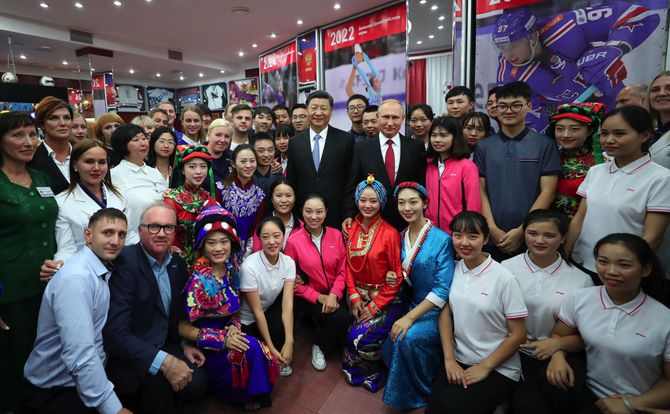China’s threat to Russia’s Far East: Real or perceived?
The vulnerability of the Far Eastern and Siberian regions in Russia to the expansion of China has become a truism. Yet, most Russians seem to favor closer ties with China, and bilateral relations may be at their best in history. There are also few signs of Chinese economic penetration, at least on a level that exceeds Japan’s or South Korea’s.

In a nutshell
- Polls show ordinary Russians view China as an ally despite its burgeoning power
- Political elites see the Sino-Russian partnership as a means to offset Western pressure
- The Kremlin wants more, not less, Chinese investment in Russia’s Far East
The Siberian and Far Eastern regions of Russia account for an incredible 66 percent of the largest country in the world. Combined, the Siberian Federal District and the Far Eastern Federal District are bigger than Canada, the world’s second-largest country. The regions east of the Urals produce almost 70 percent of Russia’s exports and, with the Arctic, account for 85 percent of its national resources.
Despite all this natural wealth, Siberia and the Russian Far East have slowly fallen behind in terms of economic and social development. Their current population is now just under 26 million, compared with almost 30 million in 1990. The incidence of poverty is almost 40 percent higher than the Russian average, while mortality rates and quality of life indicators are among the country’s worst. During Soviet times, household income was above the national average, but now it has subsided to about 87 percent. Crime rates are one-third higher than in the rest of Russia.
Growing disparity
The Far Eastern Federal District borders directly on China, Mongolia and North Korea to the south; the Siberian Federal District – after revisions in its boundaries decreed by Russian President Vladimir Putin in November – has a much shorter, 50-kilometer border with China and a very long one with Mongolia. These territories adjoin an emerging economic and political giant whose power and reach is growing rapidly. The three Chinese provinces bordering the Russian Far East – Heilongjiang, Jilin and Inner Mongolia – together with the adjacent Liaoning province have a combined population of 134 million.
The disproportion in economic power is even greater, for although the gross domestic product (GDP) per capita of these four provinces ($6,700 to $10,000) is comparable to that of Russia’s Far Eastern region, it is 30-40 percent higher than in the Siberian Federal District. More importantly, the economies of China’s northeastern regions have more than quintupled in nominal terms over the past decade, while Siberia’s output barely doubled. Thanks to its large natural gas, gold and minerals resources projects, Russia’s Far East has just about kept up with the growth of its Chinese neighbors.
Demographic and economic disparities have raised speculation about potential Chinese encroachment.
These raw indicators of demographic and economic strength, together with China’s rapidly modernizing armed forces, assertive foreign policy and seemingly insatiable appetite for natural resources, have given rise to speculation about whether Beijing might eventually encroach on Russia’s Siberian and Far Eastern territories. Even assuming the threat is economic and political influence rather than outright conquest, the question remains whether it is more perceived or real.
Mixed emotions
As for perceptions, there is anecdotal evidence (mostly in marginal outlets on the Russian internet) of a growing sense of unease. These include rumors of mass migration from China, along with reports of illegal logging and misuse of farmland. Some of this information appears to be filtering up to the federal level, as the Russian Federation’s Ministry of Natural Resources has recently suggested it might consider a total ban on exports of timber to China if current practices of unsustainable logging were to continue.
Even so, the dominant mood seems to be driven by warm political relations and the obvious personal chemistry between Presidents Vladimir Putin and Xi Jinping. Reputable Russian pollsters have found that some 70 percent of the population has a “good” or “very good” opinion about China, whereas only 13 percent has “bad” opinion. Some 62 percent consider China as a friendly ally, putting it in first place in a 2017 survey. These results have been relatively stable over the past two decades and solidified in face of the Western sanctions against Russia.
Feelings could be changing in the border regions, but major differences are hard to detect and the results may not be as representative. One local poll taken in 2016 shows that the overwhelming majority (80 percent) of Eastern Siberians in areas immediately bordering China view their southern neighbor as an ally and development partner. However, some 59 percent also considered China’s ascent as a potential threat to Russian interests, while 55 percent opposed a visa waiver regime between the two countries.
Mixed emotions could be more symptomatic of ordinary Russians’ attitudes toward China.
Such mixed emotions could be more symptomatic of the local mood. Another poll from the Far Eastern regions, taken more than a decade ago, showed that about 32 percent of the population had “very good” and “good” opinions about China, while 23 percent held “bad” ones.
Unfortunately, locally focused polls of Russian public opinion are rare and often lacking in methodological detail, making it hard to judge their reliability. But it seems safe to say that Russians seem to favor developing closer ties with China and view the process in very positive terms.
Political pragmatism
In the political or policy realms, there is no hint of potential danger or threats. Ardent followers of realpolitik have suggested that the “Thucydides Trap” argument outlined by the political scientist Graham Allison in his book Destined for War (2017) applies to Chinese-Russian relations as well. If so, China’s rise as a great power would inevitably produce a direct confrontation, with the potential for military conflict.
There are two main arguments to counter this logic. First is that mutual mistrust and the exercise of pure power politics can be restrained by collective institutions designed to reduce the risk of conflict. Second, Sino-Russian tensions can be alleviated by the presence of a shared foe – the United States – which serves to combine and focus the two countries’ international efforts.
This reasoning is second nature to Mr. Putin and Mr. Xi, whose careers as apparatchiks in one-party systems have made them hardened practitioners of realpolitik. Both leaders have done much to increase mutual trust and avoid the Thucydides trap. A short list of these confidence-building measures would include efforts to expand the Shanghai Cooperation Organisation (SCO), coordinate Beijing’s Belt and Road Initiative with Moscow’s plans for a Eurasian Union and foster cooperation between China and the Russian-led Collective Security Treaty Organization (CTSO). Direct military cooperation runs the gamut from joint troop exercises to shared research, technology transfers and sales of advanced weaponry.
Western sanctions and trade tensions between China and the U.S. are bringing Moscow and Beijing closer.
The historical mission of the SCO, whose official languages are Russian and Chinese, was to reduce tensions by encouraging exchanges and confidence-building measures, including monitoring the withdrawal of armed forces from border regions. The organization now stages more than 400 meetings and events a year, on subjects ranging from antinarcotics operations to banking.
So far, both Russia and China have been very careful to avoid issues that could potentially touch on the sensitivities of the other side.
Neutralizing pressure
Western sanctions against Russia and escalating trade tensions between China and the U.S. are also bringing Moscow and Beijing closer. Russians already view China as their major financial and trading partner and – with other options dwindling – even as a potential military ally in the event of war.
The Chinese have more room for a deal with the U.S., but remain deeply apprehensive about their recent brusque treatment by Washington. Ultimately, if the American aim is not just narrowing the trade deficit (easily done by purchasing some big-ticket items like Boeing jetliners) but more sweeping changes in the Chinese system (such as ending state subsidies for state-owned enterprises, or SOEs), an understanding may be very difficult to reach. Even so, Deng Xiaoping’s famous maxim about biding’s one time while increasing economic power may still apply, since it has been the powerful guiding principle of China’s ascent over the past four decades.
The SOEs are the cornerstone of the Communist Party’s power base and the foundation of China’s economy and politics. Weakening them in any way threatens to unbalance the whole system, and everyone knows how this ended in the Soviet Union.
Given such risks, both China and Russia have much to gain from a strategic partnership that helps neutralize pressure from other major powers. Even so, the relationship is still far from being a full-fledged alliance against a third party. China may also find it tactically prudent to limit its expansion for now, while at least appearing to satisfy U.S. demands.
Both sides, at the highest levels, stress that bilateral relations are “at their best in history,” as stated by Chinese Foreign Minister Wang Yi during a visit to Moscow in April 2018. Neither side appears to pose a real or potential threat to the other, either in the political or military sense.
Economic influence
What about the evident economic disparity between the two partners? China is the world’s second-largest economy, while Russia has declined to the status of an also-ran, in eleventh place. Does this make it vulnerable to a hidden agenda of Chinese economic expansion?
There are 12 so-called “advanced development” territories in Russia’s Far East. The concept resembles China’s free economic zones and was created expressly to compete with most advanced business centers in the Asia-Pacific. Advanced development territories provide tax incentives, quota-free foreign labor, and easier access to infrastructure and land, among other things.

The establishment of these enclaves appears to have caused the outcry on fringe internet outlets about proliferating production of greenhouse vegetables and over-logging. However, these areas have not yet attracted big projects or generated significant inflows of people across the border. A few Chinese companies have announced plans to begin operations, and the Russian Federation is looking into the environmental impact of logging. For now, that appears to be it.
The initiative has not moved the needle on bilateral trade, either. China, Japan and South Korea all rank closely together in the total foreign trade turnover of Russia’s Far Eastern region. Their collective share is 70 percent, divided more or less equally. This division has been rather stable over the past decade; if anything, South Korea’s share has expanded at China’s expense. The bulk of Russian exports is made up of minerals, fishery products and wood, which constitute 80 percent of the total. Imports are mostly machinery, electrical equipment, food, textiles and footwear. The trade breakdown for Siberia is similar.
To be sure, the advanced development territories were only created in 2015, so they may yet bring significant results. If they are to prove as effective as China’s special economic zones, however, a significant influx of foreign investors must be generated. But even in China’s case, it would take a leap of imagination to claim that the country’s more than 100 special economic zones have been taken over by foreigners or represent some Trojan-horse threat to Chinese sovereignty. Much the same can be said about Russia’s nascent experiment.
In terms of Chinese investment, the Belt and Road Initiative seems to have largely bypassed Siberia and the Russian Far East. The real money is headed farther south and west, toward Kazakhstan, Pakistan, Southeast Asia, and the Indian Ocean countries of South Asia and Africa. There has been much talk about interconnecting Russia’s and China’s power, rail and pipeline networks, but very little has yet been accomplished, except for some aspects of the gas pipeline project.
Migration myth
A last, often discussed issue is the demographic disparity between Russia and China, especially the latter’s vast population and possibly migratory pressure into the expanses of sparsely settled land in Siberia and the Russian Federations’ Far Eastern territories. This is perhaps the hollowest of the popular geopolitical myths about Sino-Russian relations.
People tend to follow opportunities and migrate to places that offer a better life. Only wars, economic collapse, natural disasters or the lack of a better alternative will compel them to settle for worse options. At least for now, China’s metropolitan centers offer far better opportunities than the vast wastes of Siberia and the Russian Far East. Business opportunities there might attract some industrious and entrepreneurial minds, but this sort of back-and-forth movement is typical in border areas and usually limited in scale.
Just over 8,000 Chinese migrate to Russia each year, less than 2 percent of Russia’s immigration total.
According to Rosstat, Russia’s federal statistics service, the number of Chinese migrants to Russia has held steady since 2011, averaging just over 8,000 per year. This amounts to less than 2 percent of total migration to Russia and, in absolute terms, closely matches the number of Russians emigrating to China. The scale of population movement bears no comparison with the much larger number of Chinese migrants to the U.S. or the EU countries.
Thanks to the new visa-free regime for tourist groups, the number of Chinese visiting Russia has increased dramatically. In 2017, the number of such short-term visits reached 944,000, an increase of 23 percent from the previous year. However, this total represents a tiny fraction of the 130 million outbound Chinese tourists in that year. In addition, these visa-free excursions are very tightly controlled and can only be organized by a handful of mostly state-owned travel bureaus. Individual visits to Russia still require visas.
Mass migration of hundreds of thousands of Chinese to the north would only be possible if economic growth in Russia’s eastern regions began to take off or if there were a cataclysmic event in China. Otherwise, only official encouragement from the Chinese authorities could spur such emigration, and there are no signs of that now. On the contrary, rules on foreign travel, especially by government employees, appear to be getting stricter.
Absence of malice
It is impossible to detect any political, military or economic designs on Siberia or Russian’s Far Eastern territories on the part of the Chinese authorities. No military developments have prompted the Russian side to express concern or to make unannounced counter-deployments. Instead, we have seen comprehensive efforts by both sides to instill trust.
Evidence of Chinese expansion is also lacking in the economic data, nor does there appear any intention in Beijing to spread their interests without an express invitation from Russia. Migration statistics show no evidence of significant population movements. Opinion surveys showing favorable perceptions of China by the Russian public reflects how close relations between the two countries have become on the political level.
This is not to say there is no potential for mutual distrust and future tensions. China’s economy has gone from half the size of the Soviet Union’s before the latter’s collapse to more than four times bigger than Russia’s. Chinese military expenditures are now at least twice Russia’s, according to official statistics. It would not be difficult to imagine growing Russian unease at the burgeoning power of its southern neighbor.
However, both sides have taken great pains to avoid any damage to their evolving strategic partnership, especially in the face of worsening relations with the West. So long as Beijing and Moscow are intent on maintaining this partnership, all talk of a Chinese threat to Russia will remain wishful thinking.








